- Home
- Jared Diamond
Upheaval: Turning Points for Nations in Crisis
Upheaval: Turning Points for Nations in Crisis Read online
Copyright
Copyright © 2019 by Jared Diamond
Cover design by Lucy Kim
Cover artwork copyright © Kinuko Y. Craft / National Geographic
Cover copyright © 2019 by Hachette Book Group, Inc.
Hachette Book Group supports the right to free expression and the value of copyright. The purpose of copyright is to encourage writers and artists to produce the creative works that enrich our culture.
The scanning, uploading, and distribution of this book without permission is a theft of the author’s intellectual property. If you would like permission to use material from the book (other than for review purposes), please contact [email protected]. Thank you for your support of the author’s rights.
Little, Brown and Company
Hachette Book Group
1290 Avenue of the Americas, New York, NY 10104
littlebrown.com
twitter.com/littlebrown
facebook.com/littlebrownandcompany
First ebook edition: May 2019
Little, Brown and Company is a division of Hachette Book Group, Inc. The Little, Brown name and logo are trademarks of Hachette Book Group, Inc.
The publisher is not responsible for websites (or their content) that are not owned by the publisher.
LCCN 2018952825
ISBN 978-0-316-40915-5
E3-20190406-JV-NF-ORI
Contents
Cover
Title Page
Copyright
Dedication
Prologue: Legacies of Cocoanut Grove
Two stories—What’s a crisis?—Individual and national crises—What this book is and isn’t—Plan of the book
PART 1 | INDIVIDUALS
Chapter 1. Personal Crises
A personal crisis—Trajectories—Dealing with crises—Factors related to outcomes—National crises
PART 2 | NATIONS: CRISES THAT UNFOLDED
Chapter 2. Finland’s War with the Soviet Union
Visiting Finland—Language—Finland until 1939—The Winter War—The Winter War’s end—The Continuation War—After 1945—Walking a tightrope—Finlandization—Crisis framework
Chapter 3. The Origins of Modern Japan
My Japanese connections—Japan before 1853—Perry—1853 to 1868—The Meiji Era—Meiji reforms—“Westernization”—Overseas expansion—Crisis framework—Questions
Chapter 4. A Chile for All Chileans
Visiting Chile—Chile until 1970—Allende—The coup and Pinochet—Economics until “No!”—After Pinochet—Pinochet’s shadow—Crisis framework—Returning to Chile
Chapter 5. Indonesia, the Rise of a New Country
In a hotel—Indonesia’s background—The colonial era—Independence—Sukarno—Coup—Mass murder—Suharto—Suharto’s legacies—Crisis framework—Returning to Indonesia
Chapter 6. Rebuilding Germany
Germany in 1945—1945 to 1961—Germans holding judgment—1968—1968’s aftermath—Brandt and re-unification—Geographic constraints—Self-pity?—Leaders and realism—Crisis framework
Chapter 7. Australia: Who Are We?
Visiting Australia—First Fleet and Aborigines—Early immigrants—Towards self-government—Federation—Keeping them out—World War One—World War Two—Loosening the ties—The end of White Australia—Crisis framework
PART 3 | NATIONS AND THE WORLD: CRISES UNDERWAY
Chapter 8. What Lies Ahead for Japan?
Japan today—Economy—Advantages—Government debt—Women—Babies—Old and declining—Immigration—China and Korea—Natural resource management—Crisis framework
Chapter 9. What Lies Ahead for the United States? Strengths, and the Biggest Problem
The U.S. today—Wealth—Geography—Advantages of democracy—Other advantages—Political polarization—Why?—Other polarization
Chapter 10. What Lies Ahead for the United States? Three “Other” Problems
Other problems—Elections—Inequality and immobility—So what?—Investing in the future—Crisis framework
Chapter 11. What Lies Ahead for the World?
The world today—Nuclear weapons—Climate change—Fossil fuels—Alternative energy sources—Other natural resources—Inequality—Crisis framework
Epilogue: Lessons, Questions, and Outlook
Predictive factors—Are crises necessary?—Roles of leaders in history—Roles of specific leaders—What next?—Lessons for the future
Photos
Acknowledgments
Discover More
Illustration Credits
Further Readings
About the Author
Also by Jared Diamond
I dedicate this book to the memory of my parents Louis and Flora Diamond, and to the future of my wife Marie Cohen and of my sons Max and Joshua Diamond
Explore book giveaways, sneak peeks, deals, and more.
Tap here to learn more.
PROLOGUE
LEGACIES OF COCOANUT GROVE
Two stories—What’s a crisis?—Individual and national crises—What this book is and isn’t—Plan of the book
At one or more times during our lives, most of us undergo a personal upheaval or crisis, which may or may not get resolved successfully through our making personal changes. Similarly, nations undergo national crises, which also may or may not get resolved successfully through national changes. There is a large body of research and anecdotal information, built up by therapists, about the resolution of personal crises. Could the resulting conclusions help us understand the resolution of national crises?
To illustrate personal and national crises, I’ll begin this book with two stories from my own life. It’s said that a child’s earliest datable firm memories are laid down from around the age of four years, although children also retain indistinct memories of earlier events. That generalization does apply to me, because the earliest memory that I can date is of Boston’s Cocoanut Grove fire, which happened just after my fifth birthday. Although (fortunately) I was not at the fire myself, I experienced it second-hand through the frightening accounts of my physician father.
On November 28, 1942, a fire broke out and spread rapidly through an overcrowded Boston nightclub called Cocoanut Grove (the owner’s spelling), whose sole exit became blocked. A total of 492 people died, and hundreds of others were injured, by suffocation, smoke inhalation, or being trampled or burned (Plate 0.1). Boston physicians and hospitals were overwhelmed—not just by the wounded and dying victims of the fire itself, but also by the fire’s psychological victims: relatives, distraught that their husbands or wives or children or siblings had died in a horrible way; and the fire’s survivors, traumatized by guilt, because they had survived while hundreds of other guests had died. Until 10:15 P.M., their lives had been normal, and focused on celebrating the Thanksgiving holiday weekend, a football game, and wartime leaves of soldiers. By 11:00 P.M., most of the victims were already dead, and the lives of their relatives and of the survivors were in crisis. Their expected life trajectories had been derailed. They felt ashamed that they were alive while a dear one was dead. The relatives had lost someone central to their identity. Not only for the fire’s survivors but also for Bostonians remote from the fire (including me as a five-year-old), the fire shook our faith in a world of justice. Those punished weren’t naughty boys and evil people: they were ordinary people, killed through no fault of their own.
Some of those survivors and relatives remained traumatized for the rest of their lives. A few committed suicide. But most of them, after an intensely painful several weeks during which they could not accept their loss, began a slow process of g
rieving, reappraising their values, rebuilding their lives, and discovering that not everything in their world was ruined. Many who had lost spouses went on to remarry. Even in the best cases, though, decades later they remained mosaics of their new identities formed after the Cocoanut Grove fire, and of their old identities established before the fire. We shall have frequent opportunity throughout this book to apply that metaphor of “mosaic” to individuals and nations in whom or in which disparate elements coexist uneasily.
Cocoanut Grove provides an extreme example of a personal crisis. But it was extreme only in that bad things befell a large number of victims simultaneously—in fact, so many victims that the fire also provoked a crisis demanding new solutions in the field of psychotherapy itself, as we’ll see in Chapter 1. Many of us experience individual tragedy first-hand in our own lives, or second-hand through the experiences of a relative or a friend. Yet such tragedies that strike only one victim are as painful to that victim, and to his or her circle of friends, as Cocoanut Grove was to the circles of its 492 victims.
Now, for comparison, here is an example of a national crisis. I lived in Britain in the late 1950’s and early 1960’s, at a time when it was undergoing a slow national crisis, although neither my British friends nor I fully appreciated it then. Britain was world-leading in science, blessed with a rich cultural history, proudly and uniquely British, and still basking in memories of having had the world’s largest fleet, the greatest wealth, and the most far-flung empire in history. Unfortunately, by the 1950’s Britain was bleeding economically, losing its empire and its power, conflicted about its role in Europe, and struggling with long-standing class differences and recent waves of immigrants. Things came to a head between 1956 and 1961, when Britain scrapped all of its remaining battleships, experienced its first race riots, had to begin granting independence to its African colonies, and saw the Suez Crisis expose the humiliating loss of its ability to act independently as a world power. My British friends struggled to make sense of those events, and to explain them to me as an American visitor. Those blows intensified discussions, among the British people and British politicians, about Britain’s identity and role.
Today, 60 years later, Britain is a mosaic of its new self and its old self. Britain has shed its empire, become a multi-ethnic society, and adopted a welfare state and high-quality government-run schools to reduce class differences. Britain never regained its naval and economic dominance over the world, and it remains notoriously conflicted (“Brexit”) about its role in Europe. But Britain is still among the world’s six richest nations, is still a parliamentary democracy under a figurehead monarch, is still a world leader in science and technology, and still maintains as its currency the pound sterling rather than the euro.
Those two stories illustrate this book’s theme. Crises, and pressures for change, confront individuals and their groups at all levels, ranging from single people, to teams, to businesses, to nations, to the whole world. Crises may arise from external pressures, such as a person being deserted or widowed by his or her spouse, or a nation being threatened or attacked by another nation. Alternatively, crises may arise from internal pressures, such as a person becoming sick, or a nation enduring civil strife. Successful coping with either external or internal pressures requires selective change. That’s as true of nations as of individuals.
The key word here is “selective.” It’s neither possible nor desirable for individuals or nations to change completely, and to discard everything of their former identities. The challenge, for nations as for individuals in crisis, is to figure out which parts of their identities are already functioning well and don’t need changing, and which parts are no longer working and do need changing. Individuals or nations under pressure must take honest stock of their abilities and values. They must decide what of themselves still works, remains appropriate even under the new changed circumstances, and thus can be retained. Conversely, they need the courage to recognize what must be changed in order to deal with the new situation. That requires the individuals or nations to find new solutions compatible with their abilities and with the rest of their being. At the same time, they have to draw a line and stress the elements so fundamental to their identities that they refuse to change them.
Those are among the parallels between individuals and nations with respect to crises. But there are also glaring differences that we shall acknowledge.
How do we define a “crisis”? A convenient starting point is the derivation of the English word “crisis” from the Greek noun “krisis” and verb “krino,” which have several related meanings: “to separate,” “to decide,” “to draw a distinction,” and “turning point.” Hence one can think of a crisis as a moment of truth: a turning point, when conditions before and after that “moment” are “much more” different from one another than before and after “most” other moments. I put the words “moment,” “much more,” and “most” in quotes, because it’s a practical problem to decide how brief should be the moment, how different should be the changed conditions, and how much rarer than most other moments should a turning point be for us to label it as a “crisis,” rather than just as another small event blip or a gradual natural evolution of changes.
The turning point represents a challenge. It creates pressure to devise new coping methods, when former coping methods have proved inadequate to resolve the challenge. If an individual or nation does devise new and better coping methods, then we say that the crisis has been resolved successfully. But we’ll see in Chapter 1 that the difference between success and failure in resolving a crisis is often not sharp—that success may just be partial, may not last forever, and the same problem may return. (Think of the United Kingdom “resolving” its world role by entering the European Union in 1973, and then voting in 2017 to leave the European Union.)
Let’s now illustrate that practical problem: how brief, how major, and how infrequent must a turning point be, to warrant applying the term “crisis”? How often in an individual’s lifetime, or in a millennium of regional history, is it useful to label what happens as a “crisis”? Those questions have alternative answers; different answers prove useful for different purposes.
One extreme answer restricts the term “crisis” to long intervals and rare, dramatic upheavals: e.g., just a few times in a lifetime for an individual, and just every few centuries for a nation. As one example, a historian of ancient Rome might apply the word “crisis” to only three events after the foundation of the Roman Republic around 509 BC: the first two wars against Carthage (264–241 and 218–201 BC), the replacement of republican government by the empire (around 23 BC), and the barbarian invasions leading to the Western Roman Empire’s fall (around AD 476). Of course, such a Roman historian doesn’t consider everything else in Roman history between 509 BC and AD 476 as trivial; he just reserves the term “crisis” for those three exceptional events.
At the opposite extreme, my UCLA colleague David Rigby and his associates Pierre-Alexandre Balland and Ron Boschma published a fine study of “technological crises” in American cities, which they defined operationally as periods of sustained downturn in patent applications, with the word “sustained” defined mathematically. According to those definitions, they found that an American city undergoes a technological crisis on average about every 12 years, that the average such crisis lasts for four years, and that an average American city finds itself in a state of technological crisis for about three years in every decade. They found that definition to be fruitful for understanding a question of much practical interest: what enables some but not other American cities to avoid technological crises defined in that way? But a Roman historian would dismiss the events studied by David and his colleagues as ephemeral bagatelles, while David and his colleagues would counter that the Roman historian is neglecting everything that happened in 985 years of Roman history except for three events.
My point is that one can define “crisis” in different ways, according to different freque
ncies, different durations, and different scales of impact. One can usefully study either rare big crises or frequent small crises. In this book the time scale that I adopt ranges from a few decades to a century. All of the countries that I discuss have experienced what I consider as a “major crisis” during my lifetime. That isn’t to deny that all of them also experienced more frequent smaller turning points.
Both for individual crises and for national crises, we often focus on a single moment of truth: for instance, the day when a wife tells her husband that she is filing for divorce; or (for Chilean history) the date September 11, 1973, when the Chilean military overthrew Chile’s democratic government, whose president committed suicide. A few crises do indeed arrive out of the blue with no antecedents, such as the December 26, 2004 Sumatra tsunami that suddenly killed 200,000 people, or my cousin’s death in the prime of his life when his car was crushed by a train at a railroad crossing, leaving his wife widowed and his four children orphaned. But most individual as well as national crises are the culmination of evolutionary changes extending over many years: for example, the divorcing couple’s prolonged marital difficulties, or Chile’s political and economic difficulties. The “crisis” is a sudden realization of, or a sudden acting on, pressures that have been building up for a long time. This truth was acknowledged explicitly by Australia’s Prime Minister Gough Whitlam, who (as we’ll see in Chapter 7) devised a whirlwind program of apparently major changes in 19 days of December 1972, but who downplayed his own reforms as a “recognition of what has already happened.”
Nations aren’t individuals writ large: they differ from individuals in many obvious ways. Why is it nevertheless illuminating to view national crises through the lens of individual crises? What are the advantages of this approach?
One advantage, which I often encounter in discussing national crises with friends and students, is that individual crises are more familiar and understandable to non-historians. Hence the perspective of individual crises makes it easier for lay readers to “relate to” national crises, and to make sense of their complexities.

 Why Is Sex Fun?: The Evolution of Human Sexuality
Why Is Sex Fun?: The Evolution of Human Sexuality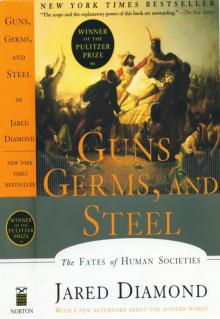 Guns, Germs, and Steel: The Fates of Human Societies
Guns, Germs, and Steel: The Fates of Human Societies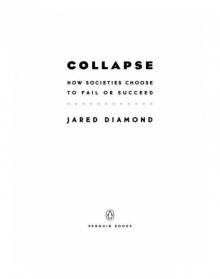 Collapse: How Societies Choose to Fail or Succeed
Collapse: How Societies Choose to Fail or Succeed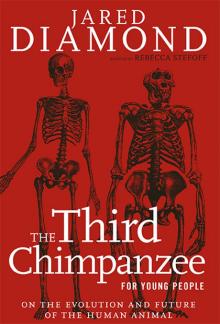 The Third Chimpanzee: The Evolution and Future of the Human Animal
The Third Chimpanzee: The Evolution and Future of the Human Animal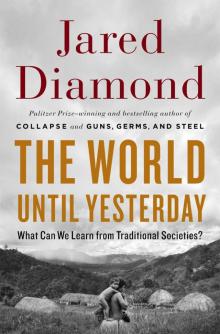 The World Until Yesterday: What Can We Learn From Traditional Societies?
The World Until Yesterday: What Can We Learn From Traditional Societies?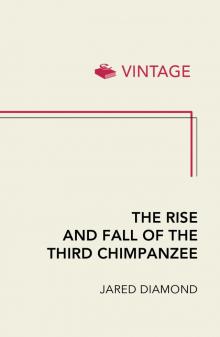 The Rise and Fall of the Third Chimpanzee
The Rise and Fall of the Third Chimpanzee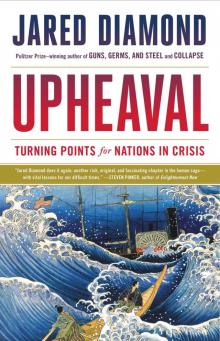 Upheaval: Turning Points for Nations in Crisis
Upheaval: Turning Points for Nations in Crisis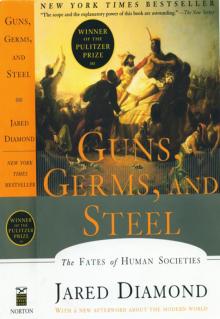 Guns, Germs, and Steel
Guns, Germs, and Steel The Third Chimpanzee for Young People
The Third Chimpanzee for Young People Why Is Sex Fun?
Why Is Sex Fun?